Effects of Weeding Frequency on the Yield and Quality of Glycyrrhiza uralensis Fisch in an Arid and Semi-Arid Area of Northwest China
Abstract
1. Introduction
2. Materials and Methods
2.1. Study Site
2.2. Experimental Set-Up
2.3. Weeds Investigation
2.4. Sampling and Measurements
2.4.1. Growth Index
2.4.2. Photosynthetic Parameters
2.4.3. Antioxidant and Nitrogen Metabolism Enzymes
2.4.4. Yield and Effective Components
2.4.5. Economic Benefit
2.5. Data Analysis
3. Results
3.1. Weeds Investigation
3.2. Growth of Licorice
3.3. Photosynthetic Parameters
3.4. Antioxidant Enzyme Activities
3.5. Nitrogen Metabolism Enzyme Activities
3.6. Yield and Effective Components
3.7. Economic Benefit
3.8. Combined Correlation Analysis of Growth and Physiological Indexes with Yield and Effective Components
3.9. PCA of Different Weeding Frequencies
4. Discussion
4.1. Effect of Weeding Frequencies on Growth of Licorice
4.2. Effect of Weeding Frequencies on Photosynthetic Parameters of Licorice
4.3. Effect of Weeding Frequencies on Antioxidant Enzyme Activities of Licorice
4.4. Effect of Weeding Frequencies on Nitrogen Metabolism Enzyme Activities of Licorice
4.5. Effect of Weeding Frequencies on Yield and Effective Components of Licorice
5. Conclusions
Author Contributions
Funding
Data Availability Statement
Acknowledgments
Conflicts of Interest
Abbreviations
| PH | Plant height |
| GD | ground diameter |
| CS | crown size |
| Pn | net photosynthetic rate |
| Tr | transpiration rate |
| G | stomatal conductance |
| Ci | intercellular CO2 concentration |
| SOD | superoxide dismutase |
| POD | peroxidase |
| CAT | catalase |
| GS | glutamine synthetase |
| NR | nitrate reductase |
| NiR | nitrite reductase |
| NG | glutamate synthase |
| DW | dry weight |
| LQ | liquiritin |
| GA | glycyrrhizic acid |
References
- Vasileiou, M.; Kyrgiakos, L.S.; Kleisiari, C.; Kleftodimos, G.; Vlontzos, G.; Belhouchette, H.; Pardalos, P.M. Transforming weed management in sustainable agriculture with artificial intelligence: A systematic literature review towards weed identification and deep learning. Crop Prot. 2024, 176, 106522. [Google Scholar] [CrossRef]
- Ekwealor, K.U.; Echereme, C.B.; Ofobeze, T.N.; Okereke, C.N. Economic importance of weeds: A review. Asian Plant Res. J. 2019, 3, 1–11. [Google Scholar] [CrossRef]
- Worthington, M.; Reberg-Horton, C. Breeding cereal crops for enhanced weed suppression: Optimizing allelopathy and competitive ability. J. Chem. Ecol. 2013, 39, 213–231. [Google Scholar] [CrossRef] [PubMed]
- Hossain, M.S.; Sarker, U.K.; Monira, S.; Ali, M.I.; Hasan, A.K.; Kaysar, M.S.; Anwar, M.P.; Begum, M.; Rashid, M.H.; Rashid, M.H.; et al. Determination of critical period for sustainable weed management and yield of Jute (Corchorus olitorius L.) under sub-tropical condition. Sustainability 2023, 15, 9282. [Google Scholar] [CrossRef]
- Adenawoola, A.R.; Aladesanwa, R.D.; Adenowuro, T.D. Effects of frequency of weeding on the growth and yield of long-fruited jute (Corchorus olitorius) in a rainforest area of southwestern Nigeria. Crop Prot. 2005, 24, 407–411. [Google Scholar] [CrossRef]
- Pahade, S.; Jha, A.K.; Verma, B.; Meshram, R.K.; Toppo, O.; Shrivastava, A. Efficacy of sulfentrazone 39.6% and pendimethalin as a pre emergence application against weed spectrum of Soybean (Glycine max L. Merrill). Int. J. Plant Soil Sci. 2023, 35, 51–58. [Google Scholar] [CrossRef]
- Moss, S. Integrated weed management (IWM): Why are farmers reluctant to adopt non-chemical alternatives to herbicides? Pest Manag. Sci. 2019, 75, 1205–1211. [Google Scholar] [CrossRef] [PubMed]
- Tomar, D.S.; Jha, A.K.; Verma, B.; Meshram, R.K.; Porwal, M.; Chouhan, M.; Rajpoot, A. Comparative efficacy of different herbicidal combinations on weed growth and yield attributes of Wheat. Int. J. Environ. Clim. Chang. 2023, 13, 889–898. [Google Scholar] [CrossRef]
- Kraehmer, H.; Laber, B.; Rosinger, C.; Schulz, A. Herbicides as weed control agents: State of the art: I. weed control research and safener technology: The path to modern agriculture. Plant Physiol. 2014, 166, 1119–1131. [Google Scholar] [CrossRef]
- Ferrero, R.; Lima, M.; Davis, A.S.; Gonzalez-Andujar, J.L. Weed diversity affects Soybean and Maize yield in a long term experiment in Michigan, USA. Front. Plant Sci. 2017, 8, 236. [Google Scholar] [CrossRef]
- Keller, M.; Böhringer, N.; Möhring, J.; Rueda-Ayala, V.; Gutjahr, C.; Gerhards, R. Changes in Weed Communities, Herbicides, Yield Levels and Effect of Weeds on Yield in Winter Cereals Based on Three Decades of Field Experiments in South-Western Germany. Gesunde Pflanz. 2015, 67, 11–20. [Google Scholar] [CrossRef]
- Ali, A.; Streibig, J.C.; Andreasen, C. Yield loss prediction models based on early estimation of weed pressure. Crop Prot. 2013, 53, 125–131. [Google Scholar] [CrossRef]
- Mubeen, K.; Yonas, M.W.; Khalofah, A.; Ikram, R.M.; Sarwar, N.; Shehzad, M.; Wasaya, A.; Rehman, H.u.; Yasir, T.A.; Aziz, M.; et al. Interference of horse purslane (Trianthema portulacastrum L.) and other weeds affect yield of autumn planted maize (Zea mays L.). Saudi J. Biol. Sci. 2021, 28, 2291–2300. [Google Scholar] [CrossRef]
- Mehriya, M.L.; Choudhary, R. Effect of combined application of herbicides on the growth, yield attributes, yield and profitability of Kharif Groundnut Arachis hypogaea (L.). Int. J. Environ. Clim. Chang. 2023, 13, 2413–2424. [Google Scholar] [CrossRef]
- Liu, C.; Yang, K.; Chen, Y.; Gong, H.; Feng, X.; Tang, Z.; Fu, D.; Qi, L. Benefits of mechanical weeding for weed control, rice growth characteristics and yield in paddy fields. Field Crop. Res. 2023, 293, 108852. [Google Scholar] [CrossRef]
- Abdallah, I.S.; Abdelgawad, K.F.; El-Mogy, M.M.; El-Sawy, M.B.I.; Mahmoud, H.A.; Fahmy, M.A.M. Weed control, growth, nodulation, quality and storability of Peas as affected by pre- and postemergence herbicides. Horticulturae 2021, 7, 307. [Google Scholar] [CrossRef]
- Liao, P.; Chen, G.; Liu, G.; Jiang, Y.; Zhao, C.; Wang, W.; Huo, Z. Effects of different density of Cyperus difformis and Ammannia baccifera on rice yield, processing and appearance quality. Acta Agric. Zhejiangensis 2022, 34, 2348–2357. [Google Scholar] [CrossRef]
- Stefanic, E.; Rasic, S.; Lucic, P.; Zimmer, D.; Mijic, A.; Antunovic, S.; Japundzic-Palenkic, B.; Lukacevic, M.; Zima, D.; Stefanic, I. The critical period of weed control influences Sunflower (Helianthus annuus L.) yield, yield components but not oil content. Agronomy 2023, 13, 2008. [Google Scholar] [CrossRef]
- Tian, Y.; Hu, Y.; Zhang, W.; Qian, K.; He, L. Effects of different weeding frequencies and methods on the yield and quality of Radix bupleuri. Plant Dr. 2021, 34, 49–57. [Google Scholar] [CrossRef]
- Walter, J.; Kromdijk, J. Here comes the sun: How optimization of photosynthetic light reactions can boost crop yields. J. Integr. Plant Biol. 2022, 64, 564–591. [Google Scholar] [CrossRef]
- Wu, A.; Brider, J.; Busch, F.A.; Chen, M.; Chenu, K.; Clarke, V.C.; Collins, B.; Ermakova, M.; Evans, J.R.; Farquhar, G.D.; et al. A cross-scale analysis to understand and quantify the effects of photosynthetic enhancement on crop growth and yield across environments. Plant Cell Environ. 2023, 46, 23–44. [Google Scholar] [CrossRef]
- Jhanzab, H.M.; Qayyum, A.; Bibi, Y.; Sher, A.; Hayat, M.T.; Iqbal, J.; Qamar, M.; Elesawy, B.H.; Ismail, K.A.; Gharib, A.F.; et al. Chemo-Blended Ag & Fe nanoparticles effect on growth, physiochemical and yield traits of Wheat (Triticum aestivum). Agronomy 2022, 12, 757. [Google Scholar] [CrossRef]
- Liu, X.; Li, N.; Ji, T.; Zhou, B.; Min, W.; Li, J.; Yang, F. Effects of microbial agents and corn protein ferment on physiological characteristics in leaves and yield of tomato. Chin. J. Appl. Ecol. 2023, 34, 3039–3044. [Google Scholar] [CrossRef]
- Dang, H.; Zhang, T.; Wang, Z.; Li, G.; Zhao, W.; Lv, X.; Zhuang, L. Differences in the endophytic fungal community and effective ingredients in root of three Glycyrrhiza species in Xinjiang, China. PeerJ 2021, 9, e11047. [Google Scholar] [CrossRef] [PubMed]
- Man, S.; Wang, J.; Gao, W.; Guo, S.; Li, Y.; Zhang, L.; Xiao, P. Chemical analysis and anti-inflammatory comparison of the cell culture of Glycyrrhiza with its field cultivated variety. Food Chem. 2013, 136, 513–517. [Google Scholar] [CrossRef]
- Chinese Pharmacopoeia Commission. The Chinese Pharmacopoeia; China Medical Science Press: Beijing, China, 2020; pp. 88–89. ISBN 9787506700778. [Google Scholar]
- Li, X.; Zhao, Z.; Chen, L.; An, H.; Li, G.; Liu, B. The status and countermeasures of development on licorices industry of Ningxia. Ecol. Econ. 2012, 12, 131–134. [Google Scholar]
- Li, X.; An, Y.; Li, H.; Jin, X. Weed control and safety of quizalofop-P-ethyl 10% EC for licorice farmland. Plant Prot. 2018, 44, 219–223. [Google Scholar] [CrossRef]
- Zhao, Z.; Fu, Y.; Qin, J.; Jin, M.; Yang, S.; Dou, X.; Yang, M. QuEchERS pretreatment coupled to gas chromatography and tandem mass spectrometry to fast determination of 34 pesticide residues in Glycyrrhizae Radix et Rhizoma. China J. Chin. Mater. Medica 2019, 44, 5094–5101. [Google Scholar] [CrossRef]
- Zuo, Z.; Niu, Y.; Zhang, A.; Wen, S. Residual status of five herbicides in artificial licorice. J. Zhejiang Agric. Sci. 2020, 61, 2001–2003. [Google Scholar] [CrossRef]
- Li, X.; Lu, J.; Yan, P.; Zhang, F. Study on Classification System and Experimental Biology of Glycyrrhiza L.; Fudan University Press: Shanghai, China, 2015; pp. 1–404. ISBN 9787309109825. [Google Scholar]
- Liu, G.; Wu, Y.; Liu, Y.; Li, X.; Yang, W. Chemical constituents in Glycyrrhiza uralensis: A review. Mod. Chin. Med. 2021, 23, 2006–2016. [Google Scholar] [CrossRef]
- Kong, S.; Li, P.; Verpoorte, R.; Li, M.; Dai, Y. Chemical and pharmacological difference between honey-fried licorice and fried licorice. J. Ethnopharmacol. 2023, 302, 115841. [Google Scholar] [CrossRef]
- Li, N.; Zhang, C.; Zhong, G.; Xiu, L.; Liu, H.; Chen, S.; Chen, F.; Li, M.; Liao, W.; Ren, Y. Research progress on chemical constituents and pharmacological effects of different varieties of Glycyrrhizae Radix et Rhizoma and predictive analysis of quality markers. Chin. Tradit. Herb. Drugs 2021, 52, 7680–7692. [Google Scholar] [CrossRef]
- Hao, J.; Liu, J.; Zhang, L.; Jing, Y.; Ji, Y. A study of the ionic liquid-based ultrasonic-assisted extraction of isoliquiritigenin from Glycyrrhiza uralensis. BioMed Res. Int. 2020, 2020, 7102046. [Google Scholar] [CrossRef]
- Lee, E.J.; Shaikh, S.; Ahmad, K.; Ahmad, S.S.; Lim, J.H.; Park, S.; Yang, H.J.; Cho, W.-K.; Park, S.-J.; Lee, Y.-H.; et al. Isolation and characterization of compounds from Glycyrrhiza uralensis as therapeutic agents for the muscle disorders. Int. J. Mol. Sci. 2021, 22, 876. [Google Scholar] [CrossRef]
- Bai, H.; Bao, F.; Fan, X.; Han, S.; Zheng, W.; Sun, L.; Yan, N.; Du, H.; Zhao, H.; Yang, Z. Metabolomics study of different parts of licorice from different geographical origins and their anti-inflammatory activities. J. Sep. Sci. 2020, 43, 1593–1602. [Google Scholar] [CrossRef]
- Zhang, D.; Liu, Y.; Yang, Z.; Song, X.; Ma, Y.; Zhao, J.; Wang, X.; Liu, H.; Fan, L. Widely target metabolomics analysis of the differences in metabolites of licorice under drought stress. Ind. Crop. Prod. 2023, 202, 117071. [Google Scholar] [CrossRef]
- Yang, L.; Jiang, Y.; Zhang, Z.; Hou, J.; Tian, S.; Liu, Y. The anti-diabetic activity of licorice, a widely used Chinese herb. J. Ethnopharmacol. 2020, 263, 113216. [Google Scholar] [CrossRef] [PubMed]
- Li, R.; Jin, Q.; Li, Z.; Wang, Y.; Peng, Z.; Duan, L. Salicylic acid improved salinity tolerance of Glycyrrhiza uralensis Fisch during seed germination and seedling growth stages. Acta Agron. Sin. 2020, 46, 1810–1816. [Google Scholar] [CrossRef]
- Huang, W.; Gao, J.; Wang, N.; Li, B.; Sun, X.; Xie, P.; Yang, J.; Sun, C. Study on seed germination characteristics of Glycyrrhiza uralensis Fisch. Seed 2018, 37, 12–15. [Google Scholar] [CrossRef]
- Zhu, L.; An, W.; Xie, J.; Zhan, F.; Liu, Y. Influence of seeding date on Glyrrhiza uralensis Fisch surviving through winter and growth characteristic of root system. J. Desert Res. 2007, 27, 469–472. [Google Scholar]
- Ye, J.; Qiu, D.; Zeng, Q.; Lin, H.; Zhang, H.; Wang, S.; Zhao, G. Comparisons of yields and effective constituents of various kinds of licorice in different picking time. Chin. Tradit. Pat. Med. 2016, 38, 1088–1092. [Google Scholar]
- Song, K.; Hu, H.; Xie, Y.; Fu, L. The effect of soil water deficiency on water use strategies and response mechanisms of Glycyrrhiza uralensis Fisch. Plants 2022, 11, 1464. [Google Scholar] [CrossRef]
- Huang, J.; Wang, P.; Niu, Y.; Yu, H.; Ma, F.; Xiao, G.; Xu, X. Changes in C:N:P stoichiometry modify N and P conservation strategies of a desert steppe species Glycyrrhiza uralensis. Sci. Rep. 2018, 8, 12668. [Google Scholar] [CrossRef]
- Chang, H.; Chen, P.; Ma, M. Feeding preference of Altica deserticola for leaves of Glycyrrhiza glabra and G. uralensis and its mechanism. Sci. Rep. 2020, 10, 1534. [Google Scholar] [CrossRef]
- Bond, W.J.; Midgley, J.J. Ecology of sprouting in woody plants: The persistence niche. Trends in Ecology and Evolution. Trends Ecol. Evol. 2001, 16, 45–51. [Google Scholar] [CrossRef] [PubMed]
- An, W.; Zhan, F.; Xie, J.; Liu, Y. Weed species and control measures in cultivated licorice field. Agric. Sci.-Technol. Inf. 2008, 12, 33–34. [Google Scholar] [CrossRef]
- Kaur, S.; Kaur, R.; Chauhan, B.S. Understanding crop-weed-fertilizer-water interactions and their implications for weed management in agricultural systems. Crop Prot. 2018, 103, 65–72. [Google Scholar] [CrossRef]
- Flexas, J.; Medrano, H. Drought-inhibition of photosynthesis in C3 plants: Stomatal and non-stomatal limitations revisited. Ann. Bot. 2002, 89, 183–189. [Google Scholar] [CrossRef] [PubMed]
- Joshi, R.; Wani, S.H.; Singh, B.; Bohra, A.; Dar, Z.A.; Lone, A.A.; Pareek, A.; Singla-Pareek, S.L. Transcription factors and plants response to drought stress: Current understanding and future directions. Front. Plant Sci. 2016, 7, 1029. [Google Scholar] [CrossRef] [PubMed]
- Gadelha, C.G.; Miranda, R.d.S.; Alencar, N.L.M.; Costa, J.H.; Prisco, J.T.; Gomes-Filho, E. Exogenous nitric oxide improves salt tolerance during establishment of Jatropha curcas seedlings by ameliorating oxidative damage and toxic ion accumulation. J. Plant Physiol. 2017, 212, 69–79. [Google Scholar] [CrossRef] [PubMed]
- Sheng, Z.; Meng, J.; Tao, J.; Zhao, D. Osmotic regulation, antioxidant enzyme activities and photosynthetic characteristics of tree Peony (Paeonia suffruticosa Andr.) in response to high temperature stress. Phyton Int. J. Exp. Bot. 2023, 92, 3133–3147. [Google Scholar] [CrossRef]
- Li, B.; Feng, Y.; Zong, Y.; Zhang, D.; Hao, X.; Li, P. Elevated CO2-induced changes in photosynthesis, antioxidant enzymes and signal transduction enzyme of soybean under drought stress. Plant Physiol. Biochem. 2020, 154, 105–114. [Google Scholar] [CrossRef] [PubMed]
- Saloner, A.; Bernstein, N. Nitrogen supply affects cannabinoid and terpenoid profile in medical cannabis (Cannabis sativa L.). Ind. Crop. Prod. 2021, 167, 113516. [Google Scholar] [CrossRef]
- Radušienė, J.; Marksa, M.; Ivanauskas, L.; Jakštas, V.; Çalişkan, Ö.; Kurt, D.; Odabaş, M.S.; Çirak, C. Effect of nitrogen on herb production, secondary metabolites and antioxidant activities of Hypericum pruinatum under nitrogen application. Ind. Crop. Prod. 2019, 139, 111519. [Google Scholar] [CrossRef]
- Maimunah, M.A.; Kautsar, V.; Bimantara, P.O.; Kimani, S.M.; Torita, R.; Tawaraya, K.; Murayama, H.; Utami, S.N.; Purwanto, B.H.; Cheng, W. Weeding frequencies decreased rice–weed competition and increased rice N uptake in organic paddy field. Agronomy 2021, 11, 1904. [Google Scholar] [CrossRef]
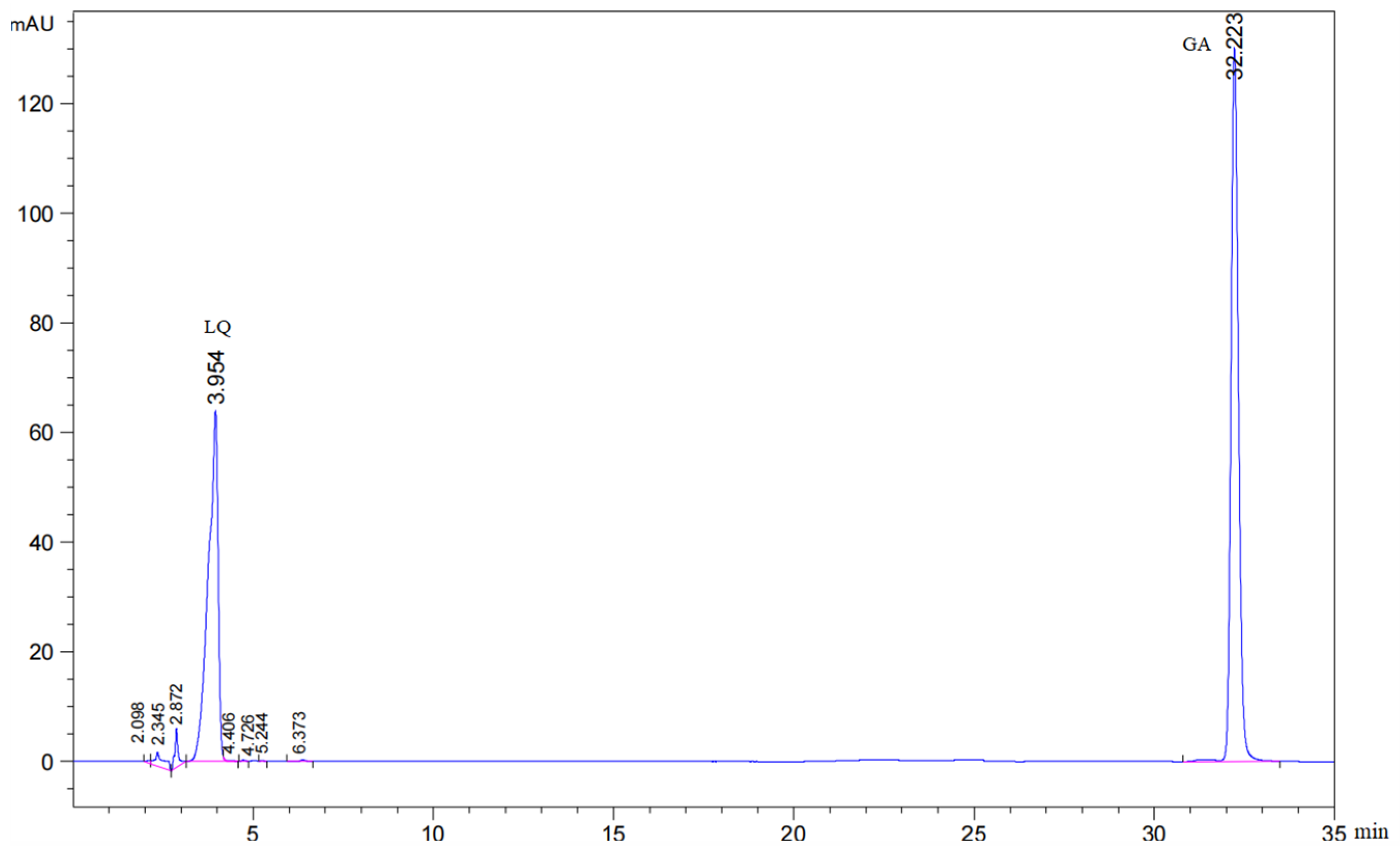
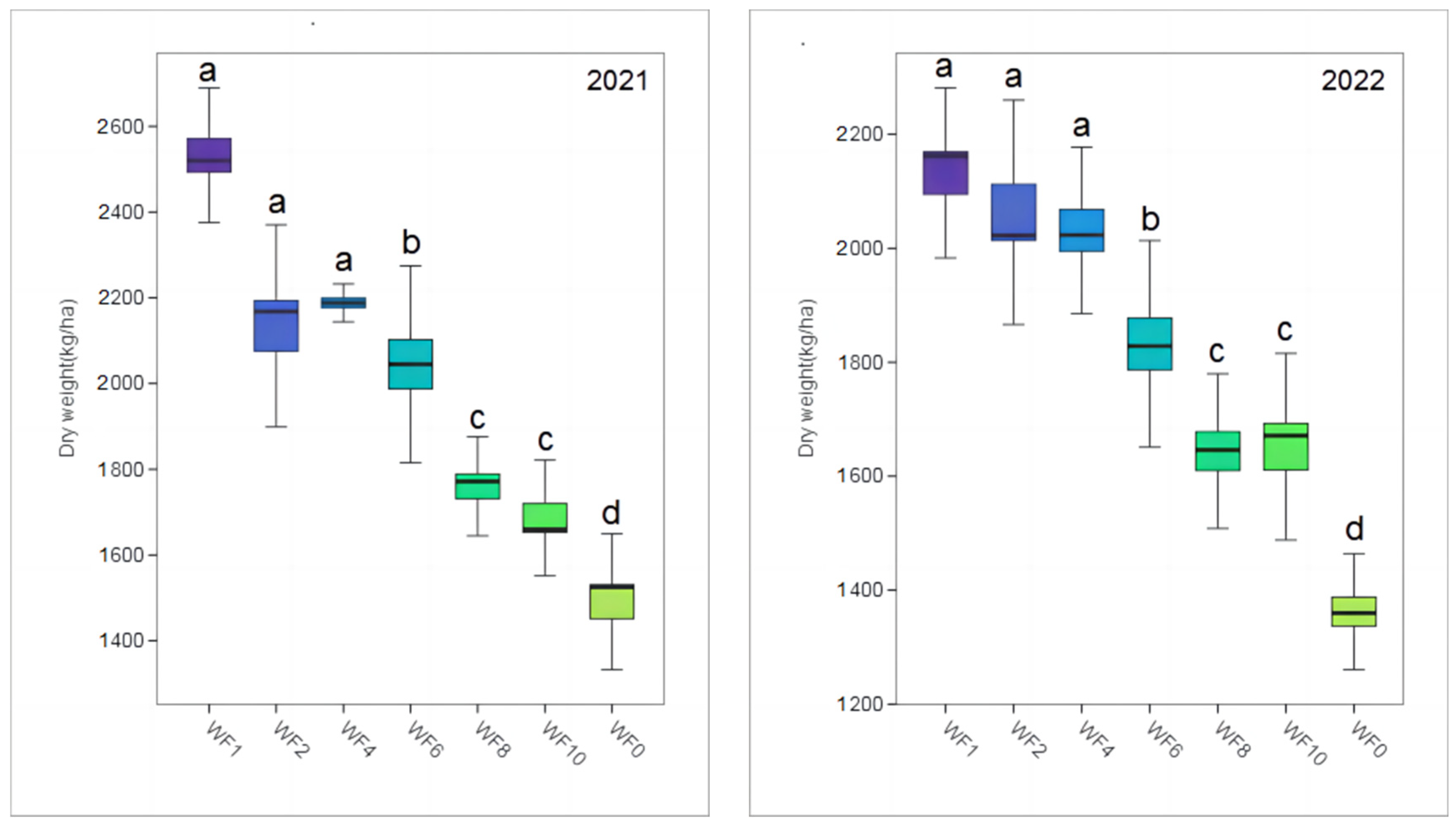
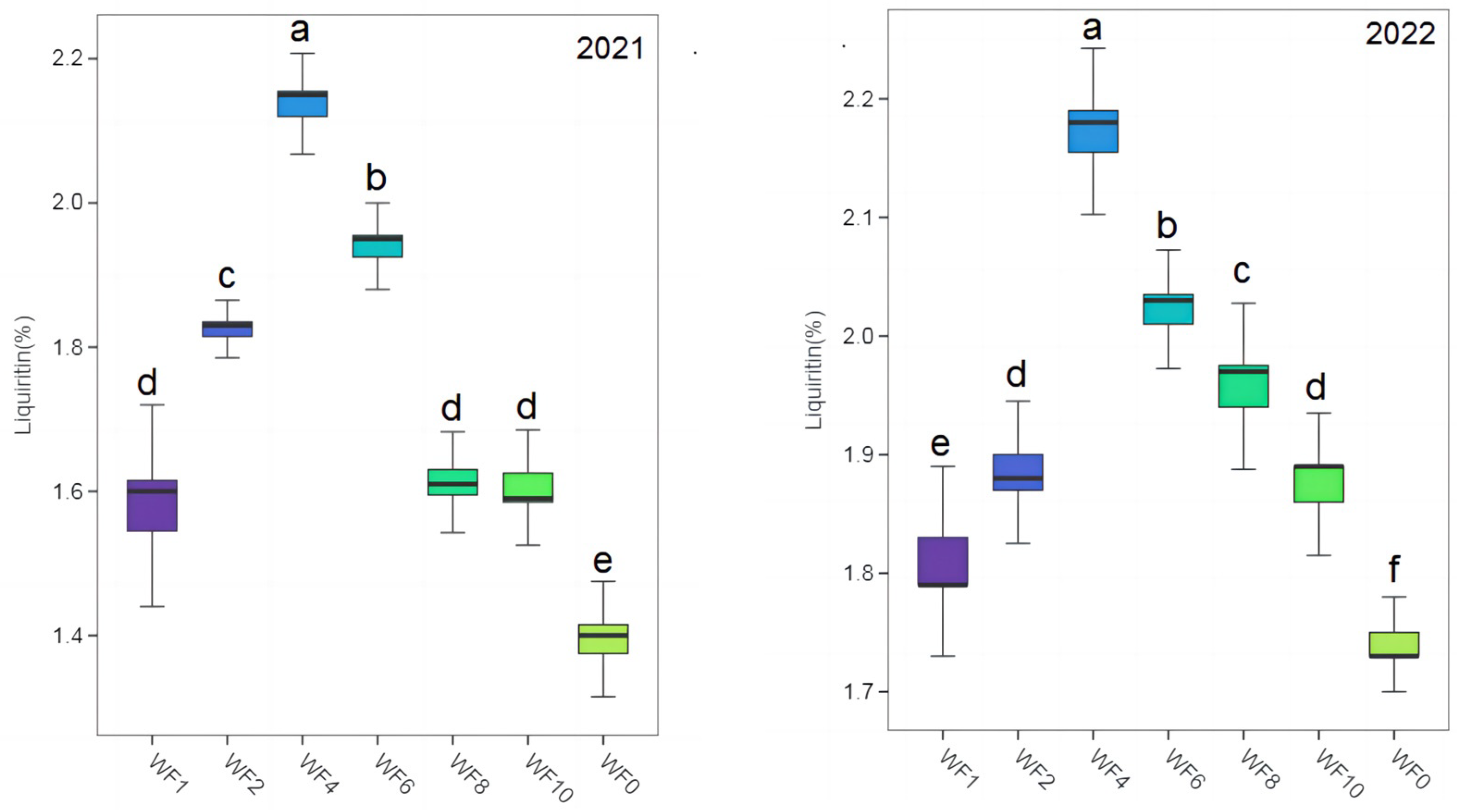


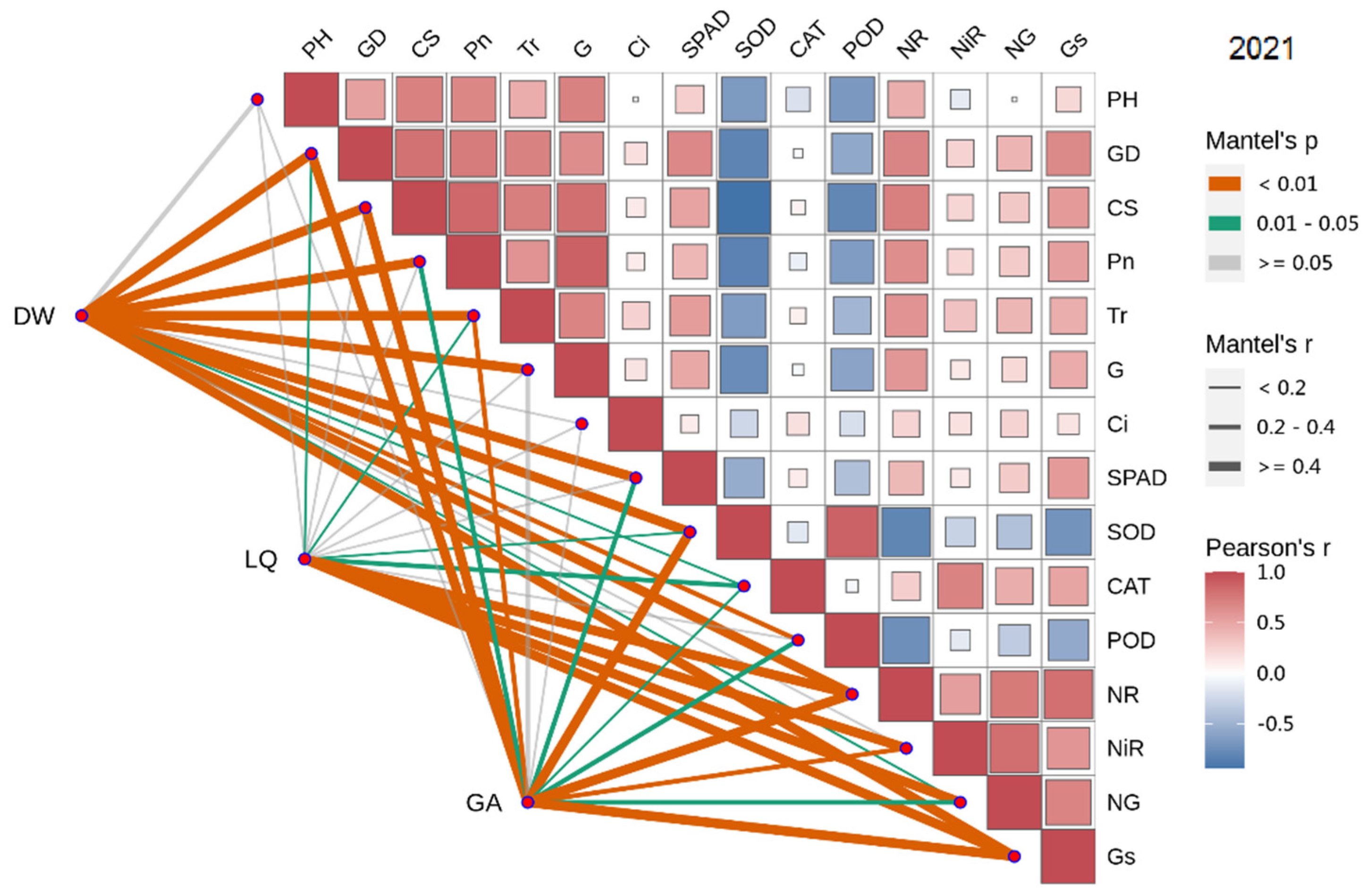
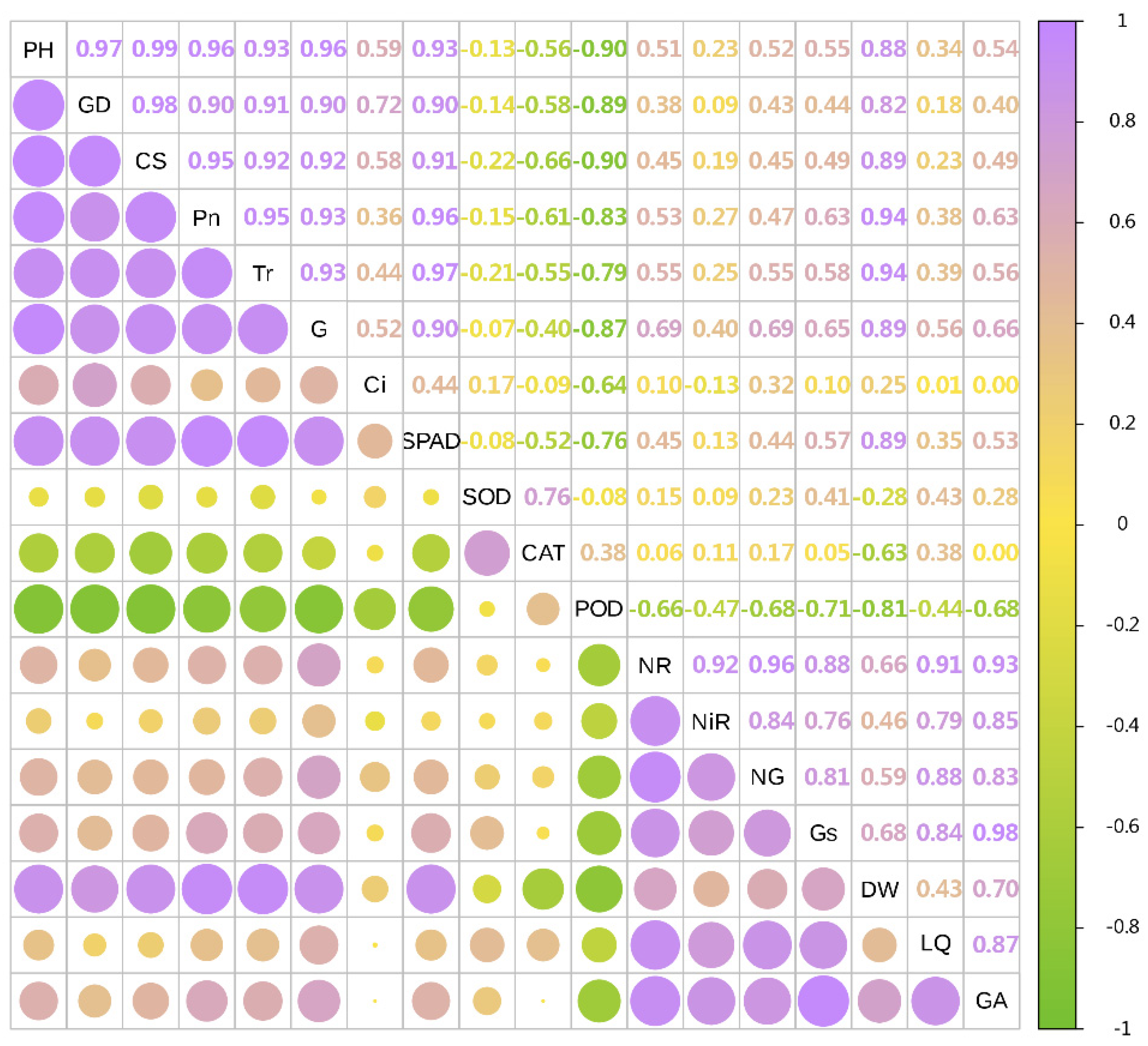
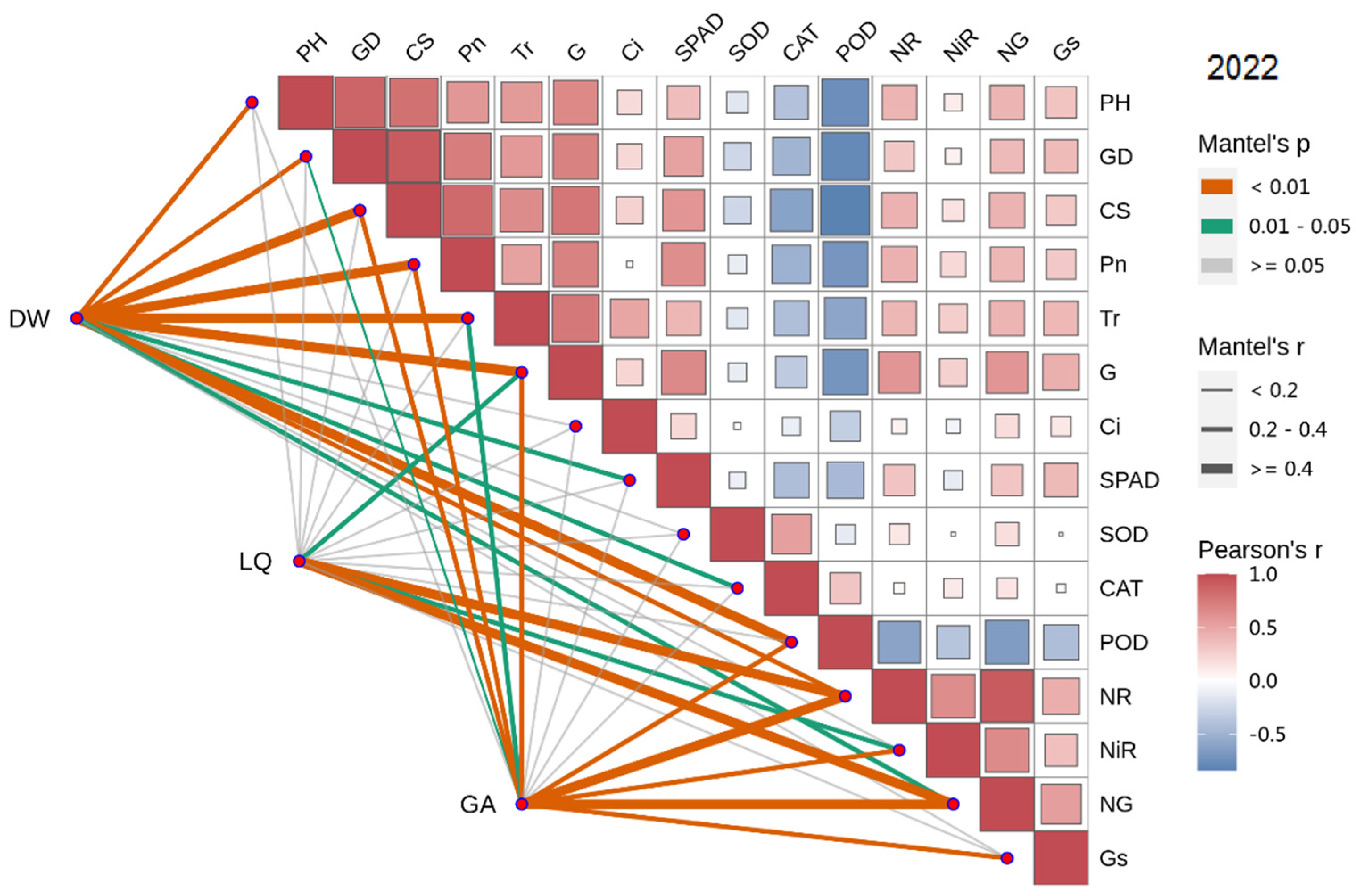

| Family | Genus | Species | Density (no.·m−2) | Biomass (g·m−2) | |
|---|---|---|---|---|---|
| 1 | Poaceae | Setaria | S. viridis | 27 | 62.12 |
| 2 | Poaceae | Echinochloa | E. crusgalli | 2 | 3.84 |
| 3 | Chenopodiaceae | Corispermum | C. declinatum | 2 | 16.52 |
| 4 | Chenopodiaceae | Chenopodium | C. album | 7 | 236.71 |
| 5 | Chenopodiaceae | Chenopodium | C. foetidum | 2 | 4.80 |
| 6 | Chenopodiaceae | Chenopodium | C. aristatum | 1 | 1.09 |
| 7 | Compositae | Artemisia | A. scoparia | 3 | 0.38 |
| 8 | Chenopodiaceae | Salsola | S. collina | 1 | 1.72 |
| 9 | Geraniaceae | Geranium | G. sibiricum | 1 | 2.64 |
| total | 46 | 329.82 |
| Year | Weeds Interference Frequency | Plant Height (cm) | Ground Diameter (mm) | Crown Size (cm2) |
|---|---|---|---|---|
| 2021 | WF1 | 51.17 ± 6.59 a | 5.51 ± 0.23 a | 963.23 ± 38.11 a |
| WF2 | 49.43 ± 5.51 ab | 5.01 ± 0.19 bc | 823.63 ± 55.35 b | |
| WF4 | 43.30 ± 1.55 bc | 5.07 ± 0.15 b | 809.19 ± 62.07 b | |
| WF6 | 40.50 ± 1.23 c | 4.93 ± 0.25 bcd | 672.96 ± 90.32 c | |
| WF8 | 42.37 ± 5.95 bc | 4.64 ± 0.24 cd | 730.74 ± 46.48 bc | |
| WF10 | 39.33 ± 2.52 c | 4.54 ± 0.21 de | 504.04 ± 30.34 d | |
| WF0 | 38.90 ± 1.73 c | 4.20 ± 0.26 e | 495.11 ± 17.91 d | |
| 2022 | WF1 | 42.67 ± 1.45 a | 5.13 ± 0.40 a | 747.52 ± 20.26 a |
| WF2 | 34.89 ± 5.05 ab | 3.93 ± 0.49 b | 586.41 ± 46.01 b | |
| WF4 | 36.89 ± 7.04 ab | 3.83 ± 0.25 b | 574.07 ± 51.27 bc | |
| WF6 | 31.44 ± 2.72 bcd | 3.73 ± 0.47 b | 470.52 ± 91.19 d | |
| WF8 | 33.00 ± 6.69 bc | 3.77 ± 0.85 b | 491.41 ± 60.78 cd | |
| WF10 | 25.00 ± 5.03 cd | 2.67 ± 0.25 c | 322.15 ± 24.30 e | |
| WF0 | 23.45 ± 5.18 d | 2.63 ± 0.23 c | 314.89 ± 13.45 e |
| Year | Weed Interference Frequency | Pn (μmol/m2·s) | Tr (mmol/m2·s) | G (mmol/m2·s) | Ci (μmol/mol) | SPAD |
|---|---|---|---|---|---|---|
| 2021 | WF1 | 34.88 ± 1.35 a | 16.19 ± 1.07 a | 890.64 ± 137.21 a | 309.03 ± 13.07 a | 44.90 ± 4.97 a |
| WF2 | 25.49 ± 2.56 bc | 13.97 ± 2.03 bc | 557.30 ± 147.16 bc | 299.63 ± 19.21 a | 41.53 ± 4.71 ab | |
| WF4 | 28.57 ± 1.48 b | 15.80 ± 0.36 ab | 629.25 ± 104.12 b | 300.38 ± 11.03 a | 40.80 ± 4.00 ab | |
| WF6 | 24.62 ± 2.41 c | 13.43 ± 1.28 c | 491.88 ± 115.33 bc | 322.00 ± 30.00 a | 41.07 ± 1.40 ab | |
| WF8 | 24.06 ± 1.54 c | 13.56 ± 0.83 c | 550.73 ± 59.40 bc | 310.73 ± 19.40 a | 40.00 ± 5.01 ab | |
| WF10 | 22.15 ± 3.67 cd | 12.97 ± 1.46 cd | 431.91 ± 43.81 cd | 293.71 ± 10.77 a | 38.33 ± 2.72 ab | |
| WF0 | 18.87 ± 1.09 d | 11.02 ± 1.03 d | 300.71 ± 10.54 d | 297.62 ± 18.33 a | 33.77 ± 7.35 b | |
| 2022 | WF1 | 22.43 ± 3.23 a | 12.15 ± 1.71 a | 603.21 ± 102.03 a | 325.30 ± 12.50 a | 40.17 ± 5.29 a |
| WF2 | 20.21 ± 1.66 ab | 10.39 ± 0.81 ab | 446.60 ± 83.45 bc | 295.74 ± 5.03 a | 36.53 ± 1.18 a | |
| WF4 | 20.24 ± 4.27 ab | 10.68 ± 1.30 ab | 581.78 ± 81.98 ab | 299.37 ± 40.59 a | 36.60 ± 3.38 a | |
| WF6 | 16.15 ± 0.75 c | 10.10 ± 1.43 ab | 447.70 ± 118.98 bc | 317.73 ± 14.08 a | 34.87 ± 4.95 ab | |
| WF8 | 17.57 ± 1.21 bc | 9.36 ± 1.28 bc | 430.27 ± 116.35 bc | 315.40 ± 21.86 a | 35.77 ± 1.40 ab | |
| WF10 | 14.87 ± 0.63 cd | 9.04 ± 2.92 bc | 308.39 ± 16.75 cd | 283.54 ± 49.72 a | 33.80 ± 1.30 ab | |
| WF0 | 11.46 ± 1.34 d | 7.02 ± 0.56 c | 241.63 ± 20.23 d | 301.78 ± 10.44 a | 28.80 ± 6.94 b |
| Year | Weeds Interference Frequency | SOD (U/g FW) | CAT (μmol/min/g FW) | POD (U/g FW) |
|---|---|---|---|---|
| 2021 | WF1 | 415.23 ± 60.15 d | 128.36 ± 17.58 e | 89.16 ± 3.57 e |
| WF2 | 802.89 ± 66.61 c | 300.04 ± 10.20 c | 92.73 ± 21.40 de | |
| WF4 | 947.39 ± 50.11 c | 399.19 ± 55.07 b | 160.49 ± 32.10 c | |
| WF6 | 1122.11 ± 58.57 b | 411.90 ± 45.74 b | 181.89 ± 32.10 bcd | |
| WF8 | 1203.29 ± 129.87 b | 511.35 ± 30.34 a | 210.42 ± 17.84 bc | |
| WF10 | 2080.94 ± 119.27 a | 234.78 ± 5.96 d | 385.04 ± 7.69 a | |
| WF0 | 1967.78 ± 93.04 a | 145.63 ± 13.16 e | 256.79 ± 92.73 b | |
| 2022 | WF1 | 1648.03 ± 246.22 c | 27.87 ± 11.15 c | 21.93 ± 8.00 c |
| WF2 | 1817.54 ± 42.030 bc | 54.25 ± 13.54 c | 30.67 ± 11.72 bc | |
| WF4 | 1891.68 ± 155.685 bc | 164.43 ± 22.15 b | 34.00 ± 9.17 bc | |
| WF6 | 1990.55 ± 154.53 ab | 206.98 ± 17.16 a | 40.67 ± 1.15 c | |
| WF8 | 2255.41 ± 204.68 a | 217.55 ± 19.32 a | 50.67 ± 15.28 b | |
| WF10 | 1811.35 ± 164.48 bc | 164.41 ± 27.28 b | 124.33 ± 18.50 a | |
| WF0 | 1784.57 ± 249.06 bc | 161.76 ± 29.38 b | 102.33 ± 27.32 a |
| Year | Weeds Interference Frequency | NR (nmol/min/gFW) | NiR (μmol/h/gFW) | NG (nmol/min/gFW) | Gs (μmol/h/gFW) |
|---|---|---|---|---|---|
| 2021 | WF1 | 197.89 ± 25.41 b | 4.70 ± 0.50 d | 196.16 ± 18.75 b | 12.47 ± 0.94 ab |
| WF2 | 215.28 ± 12.58 ab | 4.90 ± 0.37 cd | 205.40 ± 10.52 b | 12.56 ± 0.61 ab | |
| WF4 | 239.58 ± 22.24 a | 7.05 ± 0.29 a | 384.95 ± 24.30 a | 13.15 ± 0.84 ab | |
| WF6 | 210.89 ± 14.29 ab | 6.26 ± 0.35 b | 390.32 ± 8.83 a | 13.31 ± 0.59 a | |
| WF8 | 128.59 ± 19.64 c | 5.65 ± 0.68 bc | 158.70 ± 13.49 c | 12.04 ± 0.69 bc | |
| WF10 | 91.20 ± 11.31 d | 4.90 ± 0.48 d | 153.46 ± 9.01 c | 10.90 ± 0.47 cd | |
| WF0 | 86.74 ± 7.44 d | 4.22 ± 0.13 d | 122.45 ± 12.51 d | 9.76 ± 0.80 d | |
| 2022 | WF1 | 98.59 ± 19.64 d | 3.55 ± 0.68 c | 205.40 ± 8.44 b | 9.47 ± 0.94 ab |
| WF2 | 147.89 ± 25.41 c | 5.13 ± 1.01 ab | 208.70 ± 13.49 b | 10.56 ± 1.42 a | |
| WF4 | 252.91 ± 39.14 a | 6.05 ± 0.29 a | 359.68 ± 11.99 a | 10.80 ± 1.41 a | |
| WF6 | 188.61 ± 23.69 b | 5.32 ± 0.89 a | 344.54 ± 9.28 a | 10.36 ± 0.52 a | |
| WF8 | 90.02 ± 11.14 d | 3.68 ± 0.74 c | 190.21 ± 11.60 b | 10.15 ± 0.84 ab | |
| WF10 | 61.20 ± 11.31 de | 3.65 ± 1.11 c | 120.62 ± 24.08 c | 9.26 ± 0.71 ab | |
| WF0 | 31.91 ± 4.54 e | 3.89 ± 0.27 bc | 108.07 ± 9.81 c | 8.51 ± 1.09 b |
| Year | Weed Interference Frequency | Weeding Costs (CNY/ha) | Gross Income (CNY/ha) | Net Income (CNY/ha) |
|---|---|---|---|---|
| 2021 | WF1 | 12,000 | 40,583.31 ± 1276.38 a | 16,583.31 ± 1276.38 bc |
| WF2 | 6000 | 33,973.09 ± 1986.02 b | 15,973.09 ± 1986.03 cd | |
| WF4 | 3000 | 35,011.40 ± 353.84 b | 20,011.40 ± 353.84 a | |
| WF6 | 1950 | 32,720.22 ± 1834.66 b | 18,770.22 ± 1834.66 ab | |
| WF8 | 1500 | 28,103.03 ± 946.79 c | 14,603.03 ± 946.79 cd | |
| WF10 | 1200 | 27,122.79 ± 1186.75 c | 13,922.79 ± 1186.75 de | |
| WF0 | 0 | 23,675.86 ± 1413.25 d | 11,675.85 ± 1413.25 e | |
| 2022 | WF1 | 12,000 | 33,955.20 ± 1312.96 a | 9955.20 ± 1312.96 d |
| WF2 | 6000 | 33,225.60 ± 1743.35 a | 15,225.60 ± 1743.35 b | |
| WF4 | 3000 | 32,548.80 ± 1177.42 a | 17,548.80 ± 1177.42 a | |
| WF6 | 1950 | 29,336.00 ± 1452.55 b | 15,386.00 ± 1452.55 ab | |
| WF8 | 1500 | 26,294.40 ± 1086.57 c | 12,794.40 ± 1086.57 c | |
| WF10 | 1200 | 26,325.60 ± 1358.29 c | 13,125.60 ± 1358.29 bc | |
| WF0 | 0 | 21,814.40 ± 815.04 d | 9814.40 ± 815.04 d |
Disclaimer/Publisher’s Note: The statements, opinions and data contained in all publications are solely those of the individual author(s) and contributor(s) and not of MDPI and/or the editor(s). MDPI and/or the editor(s) disclaim responsibility for any injury to people or property resulting from any ideas, methods, instructions or products referred to in the content. |
© 2024 by the authors. Licensee MDPI, Basel, Switzerland. This article is an open access article distributed under the terms and conditions of the Creative Commons Attribution (CC BY) license (https://creativecommons.org/licenses/by/4.0/).
Share and Cite
Wang, D.; Ma, B.; Liu, H.; Bao, Y.; Niu, Y.; Li, M. Effects of Weeding Frequency on the Yield and Quality of Glycyrrhiza uralensis Fisch in an Arid and Semi-Arid Area of Northwest China. Agronomy 2024, 14, 433. https://doi.org/10.3390/agronomy14030433
Wang D, Ma B, Liu H, Bao Y, Niu Y, Li M. Effects of Weeding Frequency on the Yield and Quality of Glycyrrhiza uralensis Fisch in an Arid and Semi-Arid Area of Northwest China. Agronomy. 2024; 14(3):433. https://doi.org/10.3390/agronomy14030433
Chicago/Turabian StyleWang, Dongqing, Bin Ma, Hua Liu, Yangmei Bao, Ying Niu, and Ming Li. 2024. "Effects of Weeding Frequency on the Yield and Quality of Glycyrrhiza uralensis Fisch in an Arid and Semi-Arid Area of Northwest China" Agronomy 14, no. 3: 433. https://doi.org/10.3390/agronomy14030433
APA StyleWang, D., Ma, B., Liu, H., Bao, Y., Niu, Y., & Li, M. (2024). Effects of Weeding Frequency on the Yield and Quality of Glycyrrhiza uralensis Fisch in an Arid and Semi-Arid Area of Northwest China. Agronomy, 14(3), 433. https://doi.org/10.3390/agronomy14030433







